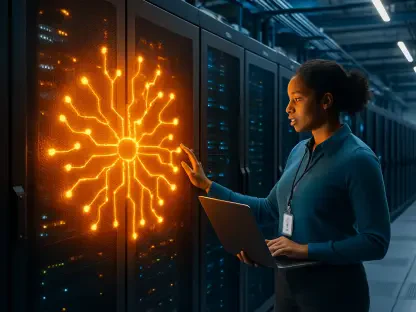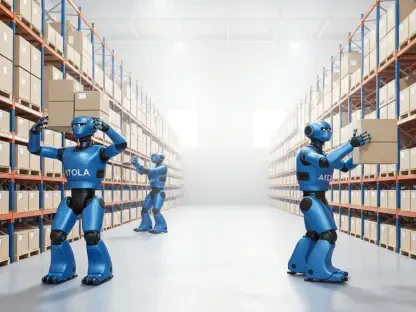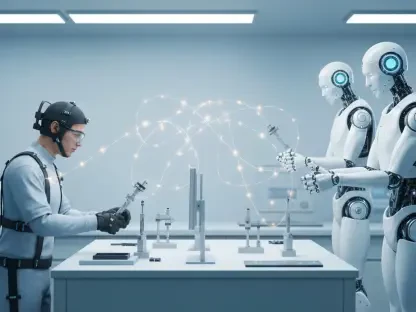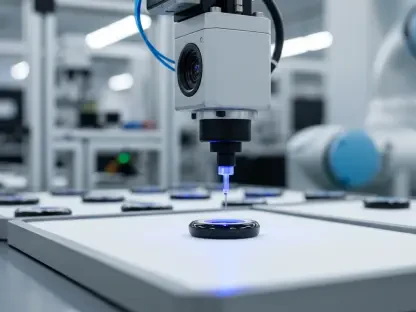The realm of humanoid robotics is captivating audiences worldwide with jaw-dropping demonstrations that seem straight out of science fiction, sparking widespread excitement. Robots like Boston Dynamics’ Atlas flipping through acrobatic routines or Tesla’s Optimus meticulously folding a shirt have fueled the notion that a robotic revolution is just around the corner. These polished performances suggest that only a few tweaks in software could transform these machines into everyday helpers, seamlessly integrated into human environments. However, beneath the sheen of these impressive showcases lies a troubling reality that experts are increasingly vocal about. A fundamental issue in the physical design of these robots threatens to undermine their potential, casting doubt on how soon—or even if—they can truly match the versatility of humans. This critical flaw, rooted not in their artificial intelligence but in their very structure, demands a closer examination to understand why the promise of humanoid robots remains tantalizingly out of reach.
Unpacking the Structural Limitations
Humanoid robots, for all their visual impressiveness, grapple with a significant hindrance in their rigid physical construction. Unlike the human body, which benefits from compliant joints and muscles that adapt fluidly to varied movements, most robots are built with stiff, unyielding frames. This rigidity poses a substantial barrier when navigating complex or uneven settings, such as stepping over jagged rocks or maneuvering through tangled undergrowth—scenarios humans handle with intuitive ease. The lack of flexibility in their design means these machines often struggle to replicate the natural grace of biological motion, rendering them less effective in real-world applications where adaptability is key. Even basic tasks can become monumental challenges, as their structures fail to absorb shocks or adjust to unexpected changes in terrain, exposing a gap between their engineered capabilities and the dynamic demands of everyday environments.
Beyond the challenge of movement, this structural stiffness translates into a glaring inefficiency in energy use, further compounding the problem. Consider Tesla’s Optimus, which consumes a staggering 500 watts per second just to maintain a slow, deliberate walk. In stark contrast, a human expends only 310 watts during a brisk stride, a far more demanding activity. This discrepancy—nearly 45% more energy for less effort—highlights how inefficient current designs are, leading to severely limited battery life. Most humanoid robots can operate for merely a few hours before requiring a recharge, a significant drawback for any practical deployment in industrial or domestic settings. Such energy demands not only restrict their operational scope but also underscore how their physical shortcomings overshadow even the most advanced computational systems driving them, raising questions about their readiness for widespread adoption.
The Pitfalls of a Software-Centric Focus
A prevailing trend in robotics development has been an overwhelming emphasis on artificial intelligence (AI) and software solutions to compensate for physical inadequacies, often termed the “brain-first” approach. This strategy relies on intricate algorithms and sophisticated vision systems to micromanage every action, from balancing to executing tasks like folding laundry. While effective for controlled demonstrations, this method falls short of the intuitive efficiency humans achieve through tactile feedback and muscle memory. The constant need for computational oversight drains power at an alarming rate and necessitates additional hardware, which in turn increases the robot’s weight. This approach, though innovative in leveraging cutting-edge AI, reveals a disconnect between the technological marvel of software and the practical necessity of a body that can operate with minimal digital intervention.
This reliance on computational power creates a self-perpetuating cycle of inefficiency that hinders progress. As more processing capacity is added to address physical limitations, the energy demands escalate, further burdening an already strained system. The added bulk from enhanced computing components only exacerbates the core issue of a body ill-suited for dynamic tasks. Despite the leaps in AI, many humanoid robots remain confined to research labs, unable to transition into viable commercial products. Their inability to perform consistently outside controlled environments stems directly from this imbalance, where the focus on brainpower overshadows the need for a fundamentally sound physical design. Until this over-dependence on software is addressed, the dream of robots as everyday assistants will remain stalled, trapped in a loop of diminishing returns.
Barriers to Hardware Innovation
The persistence of these design flaws raises a critical question: why hasn’t the robotics industry pivoted to address the evident physical shortcomings? A significant factor lies in the deep-rooted expertise of leading companies, which often centers on software and AI rather than hardware engineering. These firms find it more aligned with their strengths to refine algorithms and computational models than to overhaul the structural foundation of their creations. Additionally, existing supply chains are tailored for producing high-precision motors and sensors, components that fit the current paradigm but fall short of supporting the advanced materials or biomechanical innovations needed for more adaptive, flexible bodies. This entrenched focus creates a formidable barrier to rethinking the very framework on which these robots are built.
Moreover, the transition to a hardware-centric approach presents daunting financial and logistical challenges that deter immediate action. Redesigning the physical structure of humanoid robots isn’t merely a matter of engineering a new joint or material; it requires the establishment of an entirely new manufacturing ecosystem. Such an undertaking demands substantial investment, long-term commitment, and a willingness to navigate uncharted territory—risks that many companies are hesitant to embrace. The inertia of staying with familiar, software-driven solutions is further reinforced by the immediate, marketable appeal of AI advancements, which can be showcased more readily than the slow, complex process of hardware reinvention. Until these systemic hurdles are overcome, the industry remains tethered to an approach that, while comfortable, continues to limit the true potential of humanoid technology.
Embracing Nature’s Blueprint for Change
A promising path forward emerges in the concept of mechanical intelligence (MI), a design philosophy that draws inspiration from the adaptive brilliance of natural systems. This approach prioritizes creating robot bodies capable of passively responding to their surroundings without the constant need for energy-intensive software control. Examples from nature, like the way a pine cone’s scales shift with humidity or a hare’s tendons store and release energy during motion, demonstrate how physical structures can autonomously handle complex functions. If humanoid robots could integrate similar principles—such as soft materials for grip or flexible joints for impact absorption—their energy consumption could be dramatically reduced, while their ability to navigate unpredictable environments would see a significant boost, bringing them closer to biological efficiency.
Research efforts are already underway to translate these natural insights into practical robotic solutions, offering a glimpse of what’s possible. At institutions like London South Bank University, scientists are developing hybrid hinges that merge the precision of rigid components with the adaptability of compliant designs, aiming to replicate human-like movement. Such innovations could enable robots to tackle real-world challenges with a level of grace and efficiency currently out of reach, freeing up computational resources for higher-level tasks like strategic thinking or social interaction. By balancing MI with AI, rather than pitting hardware against software, the robotics field could finally address the root of its design flaws. This shift, though still in its early stages, signals a potential turning point, where robots might one day move beyond lab curiosities to become integral parts of daily life.
Charting the Future of Robotic Design
Reflecting on the journey of humanoid robotics, it’s evident that while technological strides have been made, a persistent design flaw in their physical structure has held back true progress. The rigid bodies and energy inefficiencies of even the most advanced machines have confined them to controlled settings, far from the versatile helpers once envisioned. The industry’s focus on software over hardware has created a cycle of limitations, where dazzling demonstrations mask deeper, unresolved issues. Looking back, the hesitation to invest in radical hardware redesigns has been a significant roadblock, driven by entrenched practices and the high costs of innovation.
Moving ahead, the adoption of mechanical intelligence stands as an actionable solution to redefine the trajectory of this field. Prioritizing nature-inspired designs that allow robots to adapt passively to their environments could slash energy demands and enhance real-world functionality. Stakeholders must commit to building new manufacturing frameworks and fostering collaboration between academic researchers and industry leaders to drive this change. By integrating adaptive hardware with strategic AI, the next generation of robots could finally step into dynamic, unpredictable settings with confidence, transforming them from novelties into indispensable tools for society.









